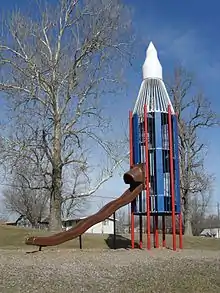Cold War playground equipment
Cold War playground equipment was intended to foster children's curiosity and excitement about the Space Race. It was installed during the Cold War in both communist and capitalist countries.

United States
In 1959, Popular Mechanics wrote that a Kiwanis Club in Ontario, California was "in tune with the times" when it erected a three-story rocketship in a local playground.[1]
Around 1962, a 26-foot (7.9 m) high Moon rocket was installed in a playground in Calwa, California. The "Calwa Rocket", described as "an affectionate symbol of an earlier time", and was designated a heritage property in 2013.[2]
The "space-age shift" in playground design was described in a 1963 issue of Life magazine, which featured Fidel Castro on the cover. A row of tree trunks installed in a Kansas City, Missouri park could elicit "any game an imaginative child might think up," including "an array of ICBMs on a launch pad."[3]
By 1963, Philadelphia had installed 160 space-aged playgrounds, which featured satellites, rockets, and submarines.[3]
Richardson, Texas installed a space-themed playground in 1965, with a radar tower, Saturn climber, submarine, radar dish, planet climber, and three-story high rocket ship. When the city tried to replace the playground equipment in 2008, it was met with local opposition. A task force established to investigate the removal found the rocket ship had "very limited play value," and had "hazardous conditions that present a great danger to young children."[4] The playground equipment was dismantled despite the objections.[5]
Two companies were noted for their military and space-themed playground equipment: Miracle Equipment Company of Grinnell, Iowa, and Jamison Fantasy Equipment of Los Angeles, California, which manufactured a moon rocket, nautilus submarine, and space slide.[2]
Author Fraser MacDonald wrote "nuclear weapons were made intelligible in, and transposable to, a domestic context" through children's toys and playground equipment featuring Cold War symbols.[6]
Eastern Bloc
Playgrounds in the Soviet Union were also designed to stimulate children's excitement about space, as this was an ideology supported across Communist states. Eastern Europe "followed the Soviet playgrounds movement and was under the influence of the Cold War fashion."[7]
The success of the Soviet space program was celebrated through monuments, parks and museums. In Baikonur, Kazakhstan, where Yuri Gagarin was launched into orbit in 1961, rocket-shaped playground equipment and other mementos of Soviet space exploration were installed around the village.[8][9]
Playground equipment—including rockets—was usually mass-produced at large manufacturing plants which tended to follow repetitive designs and patterns. As a result, playgrounds across the Soviet sphere of influence often featured identical equipment, with "brutal construction" and "generous use of old tires."[8]
Gallery
 Radar climber in Riverside, Iowa, United States
Radar climber in Riverside, Iowa, United States Soviet Space Probe
Soviet Space Probe Missile in Washington, Iowa, United States
Missile in Washington, Iowa, United States Thetford, England
Thetford, England Richardson, Texas, United States
Richardson, Texas, United States Dresden, East Germany. Photo by Richard Peter.
Dresden, East Germany. Photo by Richard Peter. Toronto, Ontario, Canada
Toronto, Ontario, Canada Rocket Hill Park, Hutchinson, Minnesota, United States
Rocket Hill Park, Hutchinson, Minnesota, United States Princeton, Missouri, United States
Princeton, Missouri, United States Radar defense station, United States
Radar defense station, United States Radar climber, United States
Radar climber, United States Playground rocket at Rocket Park, Mount Albert, Auckland, New Zealand
Playground rocket at Rocket Park, Mount Albert, Auckland, New Zealand
References
- "Playground Rocket Ship Has Three-Story Cages". Popular Mechanics. Hearst Magazines. July 1959. p. 133. Retrieved 2019-06-12.
- "Historic Preservation Commission Agenda" (PDF). City of Fresno. June 24, 2013. Archived from the original on September 17, 2016.
- "Playgrounds Take a Space-Age Spin". Life. March 15, 1963. p. 97.
- "Heights Park Master Plan: Playground Task Force Recommendations". City of Richardson, TX. June 16, 2008. Archived from the original on 2019-06-12.
- Wilonsky, Robert (July 14, 2008). "From Such Great Heights to New Lows, the Dismantling of Richardson's Historic "Rocket Ship" Park". Dallas Observer. Archived from the original on 2018-10-25. Retrieved 2019-06-12.
- Macdonald, Fraser (2008-11-26). "Space and the Atom: On the Popular Geopolitics of Cold War Rocketry" (PDF). Geopolitics. 13 (4): 611–634. doi:10.1080/14650040802275479. hdl:20.500.11820/ba1120fd-92b9-41c9-9e16-dad2e40a3139. ISSN 1465-0045. S2CID 145537264.
- Firinci, Turkan; Stankov, Georgi (2013-04-24). My Dream Playground Workshop: Involving Children in Participatory Design. ARCHHIST '13 – via Academia.edu.
- Richter, Darmon (December 4, 2013). "The Essential Guide to Soviet Playgrounds: Fun & Games in the USSR". Atlas Obscura. Archived from the original on 2017-10-15. Retrieved 2019-06-12.
- "In Salvaging Cold War Industries, Russia Trains Eyes on Space". Newsweek. December 26, 2013.